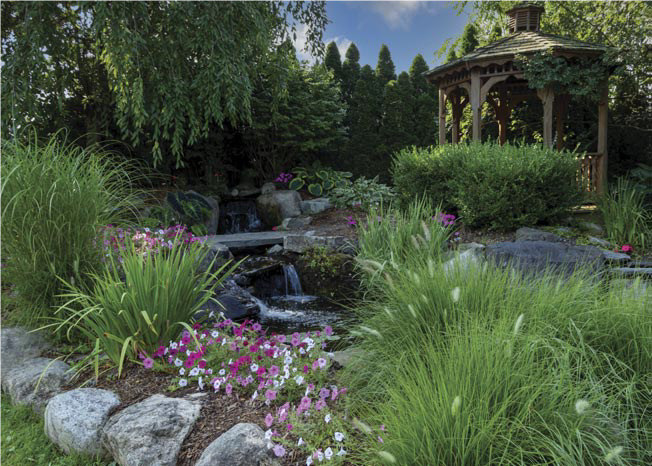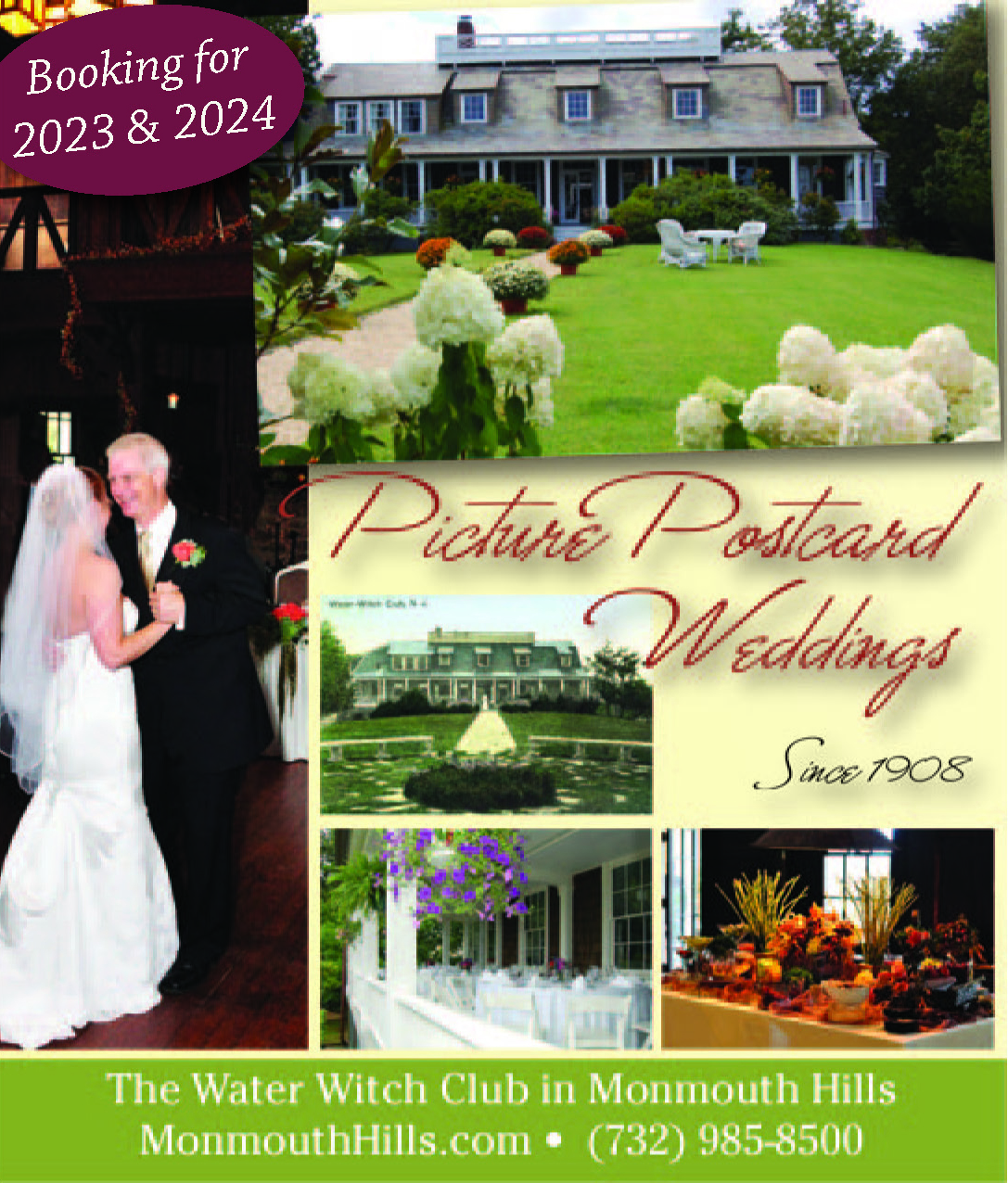A custom water feature may be just what the doctor ordered.
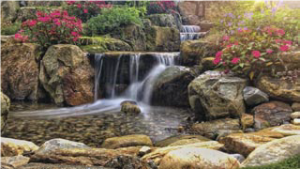
Atlantis Water Gardens
For countless thousands of New Jersey home buyers, proximity to water is practically a force of nature. It is the non-negotiable must-have—the dream that must be realized, the box that absolutely must be checked—often beyond all budgetary reason. Three years ago, I wrote a post-Sandy, pre-COVID feature for EDGE entitled “Liquid Gold,” which explored the impact of water on property values. It focused on lakefront, riverfront and oceanfront property. With waterfront land a finite resource and financial reach—more so today than back in 2019— I decided to turn my attention toward something significantly more attainable and a bit closer to home: the backyard.
The fact is, for every Garden State home with direct access to water, there are dozens (probably even hundreds) featuring meticulously designed, constructed and maintained gardens that offer the sights and sounds of H2O and all of the good things that go with it. Those good things include everything from basic stress-reduction to all manner of healing powers. Healthy ions found in moving bodies of water have been shown to improve the flow of oxygen to the brain and increase alertness and mental energy. Water features can be found in every conceivable environment, including expansive suburban landscaping projects, rooftops and patios, and even postage-stamp urban oases.
In landscape architecture, a water feature is defined as any of a range of items that introduces a man-made water design element to perform an aesthetic or recreational function. The list is impressive and includes the obvious: fountains, ponds, waterfalls, streams and, technically, swimming pools (which are not part of this story). Water features can be soothing and relaxing or they can add beauty and drama when powered by gravity, technology or, more and more, by solar energy. Water features in a backyard space are limited only by your creativity and budget. Let’s look at some of the basics…
Fountains, Ponds & Waterfalls

www.istockphoto.com
Among the more common varieties of fountains are spouting (where water shoots directly into the air) and bubbling (which gently delivers the restful sound of softly gurgling water before being recirculated). Less common are tiered fountains, which are typically larger, more ornate and more expensive. Antique lovers have plenty to work with in all three categories, as old-school cast iron fountains were made to last and can still be found fairly easily. The common denominator for all fountains is that they produce the gratifying acoustics of moving water, often accompanied by a refreshing mist to provide a peaceful, soothing and even healing retreat. Whether very new or very old, all fountains are powered by small, efficient and relatively inexpensive plug-and-play pumps. Your main involvement as a homeowner is cleaning out the filters when necessary.
Like fountains, man-made ponds tend to reflect an owner’s taste and style. They can emulate a totally natural setting (which usually requires less maintenance and expense) or create a design extension of a home, pool or patio. Pond owners quickly discover that there are endless ways to populate these environments with aquatic plants and animals; few excursions are more fun than a visit to a pond store. The most difficult decision they face is fish vs. no fish. While some opt for the serene beauty of water hyacinth and lily varieties—or the drama of towering iris—others find the lure of goldfish and koi irresistible.
While these are resilient animals, they may not survive year ’round in a pond that hasn’t been set up to accommodate their needs. Fish can make it through a winter freeze-over if the pond is deep enough and a heater keeps an unfrozen hole of water open for harmful gasses to escape. To some people, fish become cherished pets—especially if their kids name them! Each fall, they scoop ’em up and move them to an indoor bowl or tank.
Regardless of your level of personal attachment, don’t forget that once you add fish (or other pond animals), the pump and filter will require consistent cleaning. Also, be aware of the bird of prey population in your area and imagine how your pond appears to a hungry raptor. You may want to obscure or shade it in some way, or it will look like a sushi platter to your friendly neighborhood osprey.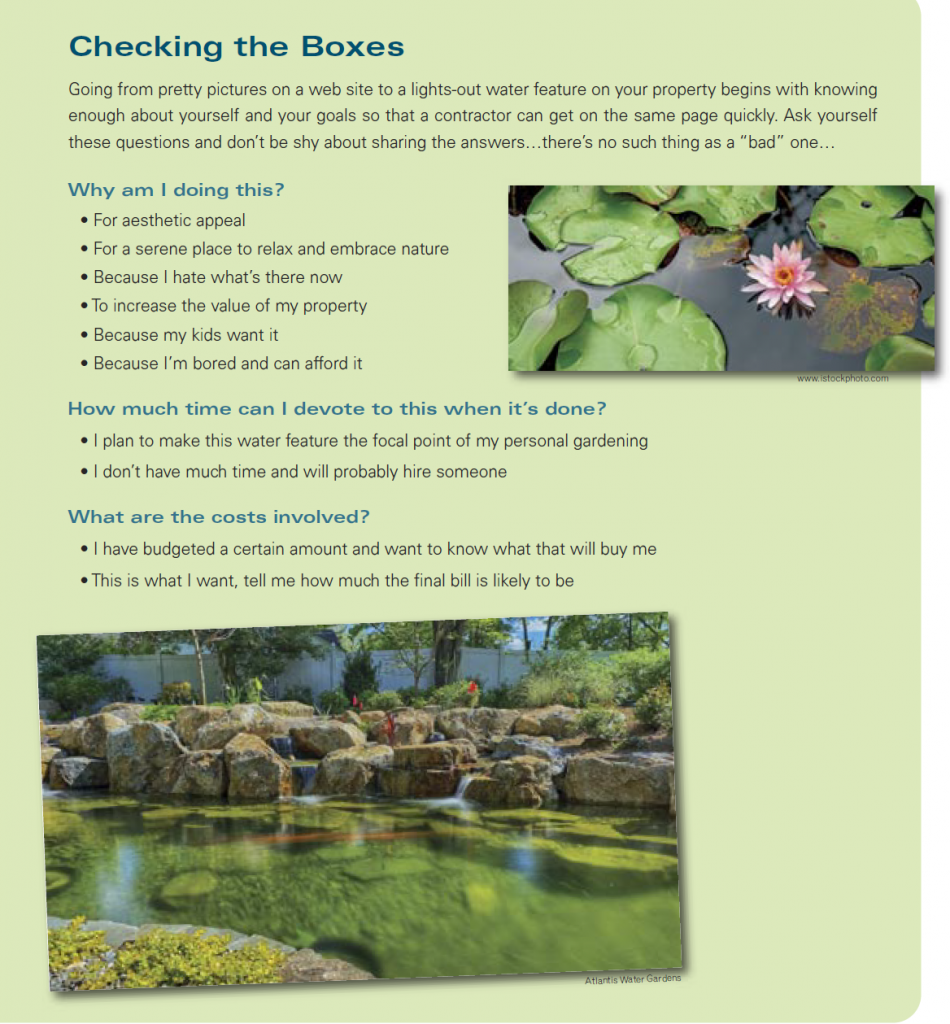
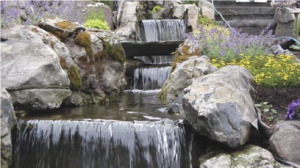
Aquatic Art
For those who cannot truly relax without the sound of rushing water, a backyard waterfall is the perfect home improvement. While certain pond and fountain projects can be tackled by DIYers, designing and building a waterfall almost always involves an experienced professional.
Waterfalls are usually integrated into an existing or planned swimming-pool design or installed as a standalone feature that takes advantage of natural elements on your property, such as rock outcroppings or boulders, which are capable of supporting a waterfall as an independent structure. An interesting alternative to a waterfall is a waterwall.
Waterwalls are visually striking structures that generate a continuous curtain of cascading H2O, offering many of the same benefits of a traditional waterfall, particularly if you are constricted by space and/or expense. Along the same lines, water sconces—which have been around for centuries—deliver the soothing trickle in an even smaller space.
What Does it Cost? What is it Worth?
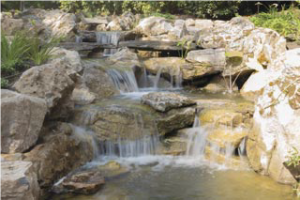
Aquatic Art
Let’s look at the second question first. Does a water feature add enough value to your property to justify the expense? As is the case with a swimming pool, the answer is a firm maybe. Home buyers tend to either want a pool or not. Where fountains, ponds and waterfalls are concerned, they unquestionably add to the esthetic appeal of a home—after all, that’s why they were built in the first place. Of course, someone could “love the house and hate the pond,” but that is a matter of taste and an unwanted water feature can be dismantled or filled in without significant expense, if that’s the way the new owner wants to go. A realtor looking at this question would hope that a beautiful fountain might prove to be the deciding factor between two homes…or that it captures the imagination of an otherwise hesitant buyer enough to make an offer on a listing.
The folks who design, build and install custom water features look at it more organically, as they should. If the project is within your financial wherewithal, measure it not in dollars, but rather in the degree of satisfaction and enjoyment it brings.
For most people the first step toward basic answers is meeting with experienced professional contractors capable of delivering a personalized water feature creation. Two that have demonstrated decades of success in the design and construction of unique aquatic landscapes are Atlantis Water Gardens and Aquatic Art. They are among a dozen or so companies in and around New Jersey whose web sites are filled with dreamy photos of finished projects. “My business is luxury- and leisure-oriented,” says Mark Yonadi, owner of Aquatic Art. “I am creating a lifestyle, not just a water feature. My goal is that the client really uses and enjoys what I create…I design, then I build my designs. I do it because I love it.”
Jaak Harju, owner of Atlantis Water Gardens, echoes this sentiment, adding, “I want my clients to enjoy the garden from multiple vantage points, indoors and out. I want to create a living picture, something that changes with every visit.”
Both agree that a great “water gardenscape” (or water garden escape) is fueled by passion and inspiration. It is what buoyed them through the initial uncertainty of COVID, which exploded at the beginning of their busy season, in late March 2020. By that summer, however, both companies were besieged by requests from cooped-up homeowners who had nowhere to vacation other than their own backyards. “Business was booming again after only a few initial setbacks,” Harju says.
Yonadi says commercial projects tailed off during COVID, but backyard projects of all types and sizes “never experienced any hiccups.” He adds, with pride, that he managed to keep all his employees working and his team safe.
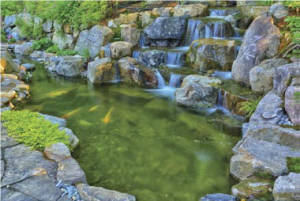
Atlantis Water Gardens
Pricing of high-quality custom water features covers a wide range based on countless variables. After all, that’s why they’re called custom. As a rule, though, figure on a starting price of $5,000 and don’t be surprised if achieving your vision runs into the mid-five figures. If you’ve got seven figures burning a hole in your bank account, that can happen, too. Harju, who was named Water Feature Artist of the Year in 2014, once worked on a commercial project in South America that priced out at $2.7 million. On the plus side, he points out, most of his projects require less time of the homeowner and involve less expense than maintaining a large suburban lawn.
HomeAdvisor recently compiled some pricing data that shouldn’t surprise New Jersey homeowners. The average price of a fountain or waterfall designed and installed is 50% higher here than the national average. This undoubtedly reflects the involvement of plumbers and electricians. By contrast, a pond installation in New Jersey is about the same as the national average.
The fish part of the equation can be exasperating for a novice, especially if they are dying or being eaten by predators. There is no such thing as a “bargain” koi, so you want to get it right as soon as possible. For his part, Yonadi spent years cultivating his aquarium skills—first as a hobby and then as a thriving part of his business. His company will stock your pond and/or aquarium, provide all the necessary equipment to sustain successful ecosystems, and offer follow-up maintenance. One final piece of advice upon which both men agree is that, during an initial consultation, a good water feature company will listen to a prospective client.
But a good client will also listen when they make a recommendation.
“Yes,” Harju smiles. “Sometimes, we know best.”

